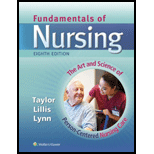
To discuss:
How and why would the student nurse respond to this situation?
Case summary:
The nursing student is caring for a 68-year-old adult male patient Mr. S, who is recently diagnosed with diabetes. In the assessment of the patient, it is found to be that the patient is 50 pounds overweight. The patient gained weight due to lack of exercise and diet maintenance. A plan care was developed for the patient to reduce his weight and maintain his diabetes. During the follow-up visit, the nursing student noticed that the patient has gained 5 pounds extra weight. The patient had an idea that his diabetes could be managed by medication and asks the nursing student about it.
Explanation of Solution
The nursing student must teach the patient what he must do to maintain his health through diet and exercise and it is his responsibility and he should take the initiative to maintain his weight.
To discuss:
The adequacy of the skills for professional practice and what that is tell about the student nurse?
Case summary:
The nursing student is caring for a 68-year-old adult male patient Mr. S, who is recently diagnosed with diabetes. In the assessment of the patient, it is found to be that the patient is 50 pounds overweight. The patient gained weight due to lack of exercise and diet maintenance. A plan care was developed for the patient to reduce his weight and maintain his diabetes. During the follow-up visit, the nursing student noticed that the patient has gained 5 pounds extra weight. The patient had an idea that his diabetes could be managed by medication and asks the nursing student about it.
Explanation of Solution
The student nurse is still not an Advanced Practice Registered Nurse (APRN) to become a nurse educator, who counsels and educates her patients and their family members.
To discuss:
Whether to agree with the criteria that the nursing student used to evaluate a successful outcome?
Case summary:
The nursing student is caring for a 68-year-old adult male patient Mr. S, who is recently diagnosed with diabetes. In the assessment of the patient, it is found to be that the patient is 50 pounds overweight. The patient gained weight due to lack of exercise and diet maintenance. A plan care was developed for the patient to reduce his weight and maintain his diabetes. During the follow-up visit, the nursing student noticed that the patient has gained 5 pounds extra weight. The patient had an idea that his diabetes could be managed by medication and asks the nursing student about it.
Explanation of Solution
The nursing student did make a successful evaluate in educating her patients. The nursing student knows that the patient lack exercise and poor diet will lead diabetic related complications.
To discuss:
The type of teaching plan that nursing student may have used at the initial teaching session?
Case summary:
The nursing student is caring for a 68-year-old adult male patient Mr. S, who is recently diagnosed with diabetes. In the assessment of the patient, it is found to be that the patient is 50 pounds overweight. The patient gained weight due to lack of exercise and diet maintenance. A plan care was developed for the patient to reduce his weight and maintain his diabetes. During the follow-up visit, the nursing student noticed that the patient has gained 5 pounds extra weight. The patient had an idea that his diabetes could be managed by medication and asks the nursing student about it.
Explanation of Solution
The nursing student used weight plan and diet maintenance teaching plan. The nursing student taught the patient about the exercises that are involved in weight reduction and types of diet that could benefit the patient.
To discuss:
How might that teaching plan have changed based on the patient’s response at the next visit?
Case summary:
The nursing student is caring for a 68-year-old adult male patient Mr. S, who is recently diagnosed with diabetes. In the assessment of the patient, it is found to be that the patient is 50 pounds overweight. The patient gained weight due to lack of exercise and diet maintenance. A plan care was developed for the patient to reduce his weight and maintain his diabetes. During the follow-up visit, the nursing student noticed that the patient has gained 5 pounds extra weight. The patient had an idea that his diabetes could be managed by medication and asks the nursing student about it.
Explanation of Solution
The patient can be made to admit in the hospital for a period of time and teaching plan is carried out under direct supervision of the nursing student and the nursing staff who cares for the patient. This is done for the benefit of the patient, since the patient’s safety should not be compromised.
To discuss:
Would the outcomes identified initially need to be revised based on any changes in the teaching plan?
Case summary:
The nursing student is caring for a 68-year-old adult male patient Mr. S, who is recently diagnosed with diabetes. In the assessment of the patient, it is found to be that the patient is 50 pounds overweight. The patient gained weight due to lack of exercise and diet maintenance. A plan care was developed for the patient to reduce his weight and maintain his diabetes. During the follow-up visit, the nursing student noticed that the patient has gained 5 pounds extra weight. The patient had an idea that his diabetes could be managed by medication and asks the nursing student about it.
Explanation of Solution
The teaching plans and outcomes should be changed according to the patient’s response and his health status. If the patient is given different exercise and diet regimens based upon his weight and diet plan.
To discuss:
The knowledge, skills, and attitudes do you need to develop to continuously improve quality and safety when caring for child patients like Mr. N?
Case summary:
The nursing student is caring for a 68-year-old adult male patient Mr. S, who is recently diagnosed with diabetes. In the assessment of the patient, it is found to be that the patient is 50 pounds overweight. The patient gained weight due to lack of exercise and diet maintenance. A plan care was developed for the patient to reduce his weight and maintain his diabetes. During the follow-up visit, the nursing student noticed that the patient has gained 5 pounds extra weight. The patient had an idea that his diabetes could be managed by medication and asks the nursing student about it.
Explanation of Solution
- The nursing student needs good communication and interpersonal skills to gain trust and establish nurse-patient relationship.
- The nursing student must have skill to educate to her patients.
- The nursing student must change the teaching plan according to the patient’s response and his weight.
Want to see more full solutions like this?
- Discuss the current antenatal care approach for pregnant women and provide the highlight of activities conducted during woman’s antenatal visit, clearly describing the steps needed for successful antenatal care.arrow_forwardDefine obstetric emergencies and state and briefly explain any two (2) maternal, foetal, and obstetric complications that require immediate intervention.arrow_forwardExplain how mental health services can be effectively integrated into maternal and child health, visa-viz early childhood development.arrow_forward
- Enumerate any four (4) potential complications during puerperium and highlight key measures to manage these complications.arrow_forwardDescribe the physiology of the first stage of labour.arrow_forward58. Consider the circuit shown below. Find 11, 12, and I3 when (a) the switch S is first closed, (b) after the currents have reached steady-state values, and (c) at the instant the switch is reopened (after being closed for a long time). 1 R1 ww 13 12 E S 0000 ww R2arrow_forward
- Regularity- Rate- P waves- PRI- QRS- Interpretation- Normal sinus rhythm, sinus bradycardia, sinus tachycardia, sinus arrhythmia, sinus pause, sinus arrest, normal sinus with PACs, atrial fibrillation, atrial flutter, multifocal atrial tachycardia, wandering atrial pacemaker, supraventricular tachycardia, junctional rhythm, accelerated junctional rhythm, junctional tachycardia, premature junctional complex, premature ventricular complex, ventricular tachycardia, ventricular fibrillation, idioventricular rhythm, accelerated idioventricular rhythm, asystole, first-degree AV block, second-degree AV block type I (Wenckebach), second-degree AV block type II (Mobitz II), third-degree AV block (complete heart block), bigeminy, trigeminy, quadrigeminy, couplet,somatic tremor,AC interference,wandering baseline and etc (answer correctly using the 5 step method and only use those terms above)arrow_forward76. 80. 81. 82. 83. 33arrow_forward69. 70. 71. 72. 73. 74.arrow_forward
- 63. 64. 65. Rhythm: P wave: QRS Complex: Rate: PRI: Interpretation: Rhythm: P wave: QRS Complex: 66. 67. 68. Rhythm: P wave: QRS Complex: Rhythm: P wave: QRS Complex: Rate: PRI: Interpretation: Rate: PRI: Interpretation: Rate: PRI: Interpretation:arrow_forward59. 57. 60. 62. 55. سلسلہ ་་་་arrow_forward• Define the first stage of labour. • Describe the physiology of the first stage of labour. • Enumerate any four (4) potential complications during puerperium and highlight key measures to manage these complications.arrow_forward
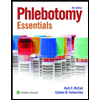 Phlebotomy EssentialsNursingISBN:9781451194524Author:Ruth McCall, Cathee M. Tankersley MT(ASCP)Publisher:JONES+BARTLETT PUBLISHERS, INC.
Phlebotomy EssentialsNursingISBN:9781451194524Author:Ruth McCall, Cathee M. Tankersley MT(ASCP)Publisher:JONES+BARTLETT PUBLISHERS, INC.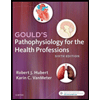 Gould's Pathophysiology for the Health Profession...NursingISBN:9780323414425Author:Robert J Hubert BSPublisher:Saunders
Gould's Pathophysiology for the Health Profession...NursingISBN:9780323414425Author:Robert J Hubert BSPublisher:Saunders Fundamentals Of NursingNursingISBN:9781496362179Author:Taylor, Carol (carol R.), LYNN, Pamela (pamela Barbara), Bartlett, Jennifer L.Publisher:Wolters Kluwer,
Fundamentals Of NursingNursingISBN:9781496362179Author:Taylor, Carol (carol R.), LYNN, Pamela (pamela Barbara), Bartlett, Jennifer L.Publisher:Wolters Kluwer,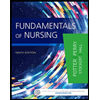 Fundamentals of Nursing, 9eNursingISBN:9780323327404Author:Patricia A. Potter RN MSN PhD FAAN, Anne Griffin Perry RN EdD FAAN, Patricia Stockert RN BSN MS PhD, Amy Hall RN BSN MS PhD CNEPublisher:Elsevier Science
Fundamentals of Nursing, 9eNursingISBN:9780323327404Author:Patricia A. Potter RN MSN PhD FAAN, Anne Griffin Perry RN EdD FAAN, Patricia Stockert RN BSN MS PhD, Amy Hall RN BSN MS PhD CNEPublisher:Elsevier Science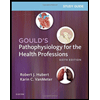 Study Guide for Gould's Pathophysiology for the H...NursingISBN:9780323414142Author:Hubert BS, Robert J; VanMeter PhD, Karin C.Publisher:Saunders
Study Guide for Gould's Pathophysiology for the H...NursingISBN:9780323414142Author:Hubert BS, Robert J; VanMeter PhD, Karin C.Publisher:Saunders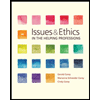 Issues and Ethics in the Helping Professions (Min...NursingISBN:9781337406291Author:Gerald Corey, Marianne Schneider Corey, Cindy CoreyPublisher:Cengage Learning
Issues and Ethics in the Helping Professions (Min...NursingISBN:9781337406291Author:Gerald Corey, Marianne Schneider Corey, Cindy CoreyPublisher:Cengage Learning





